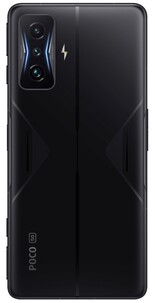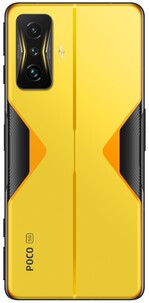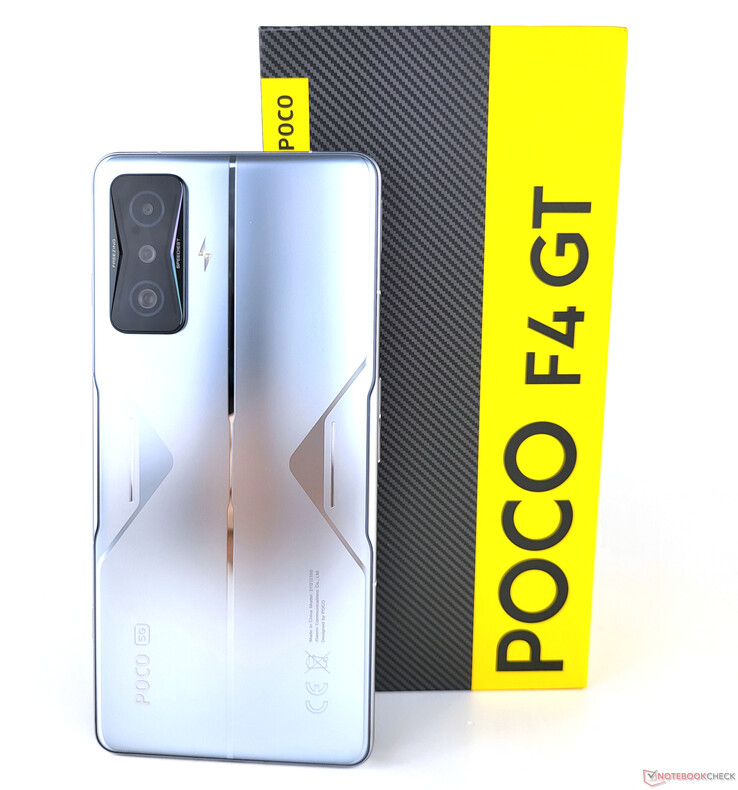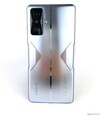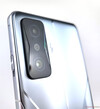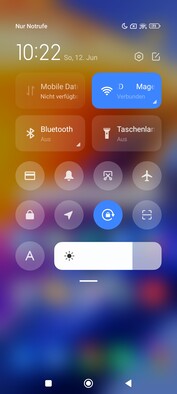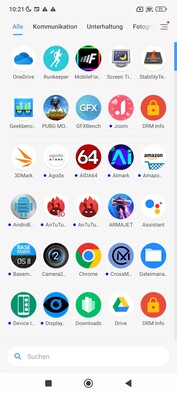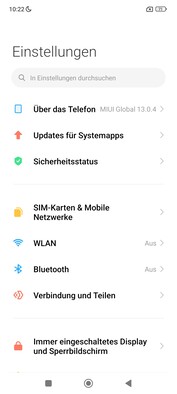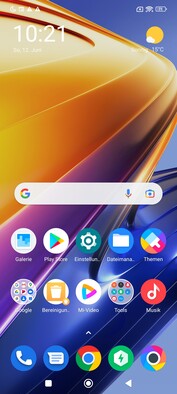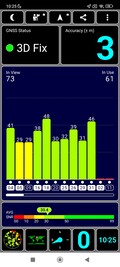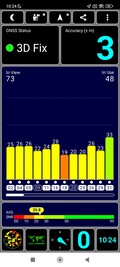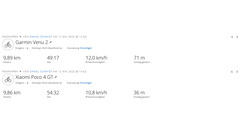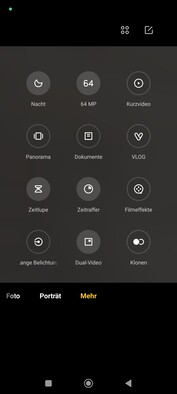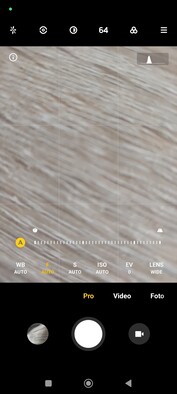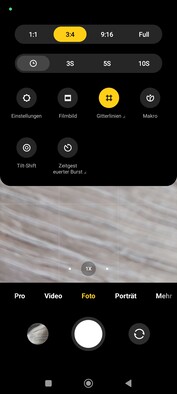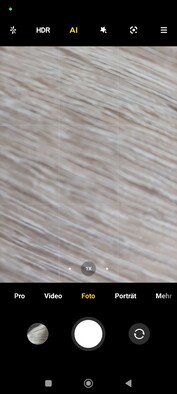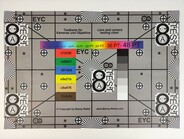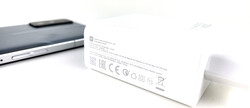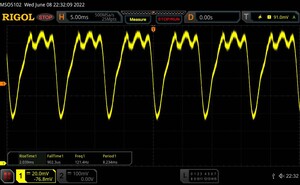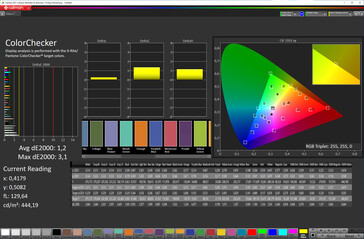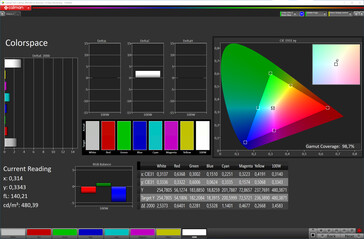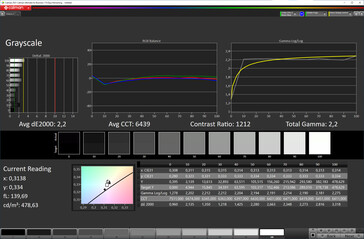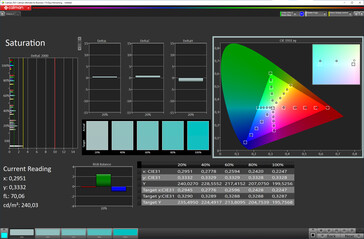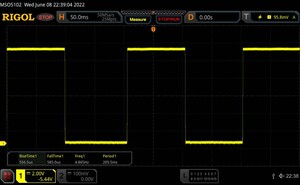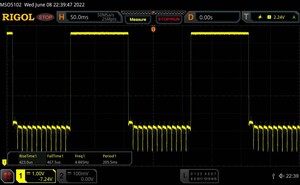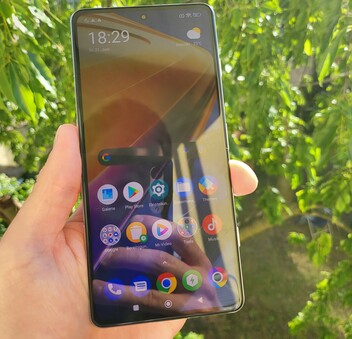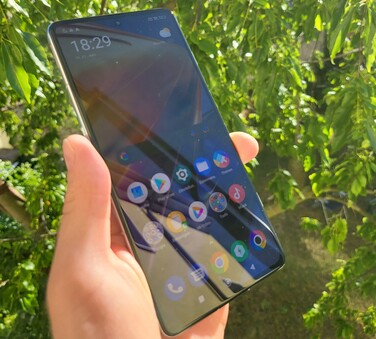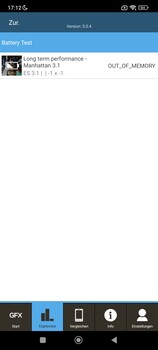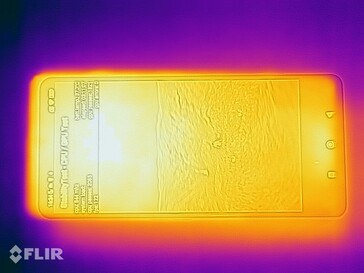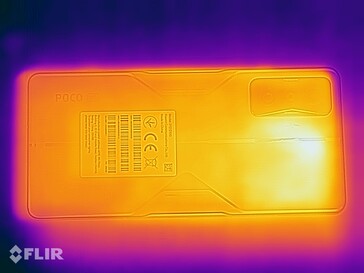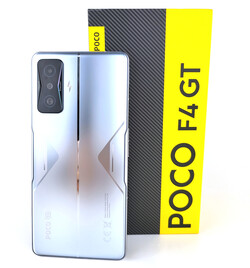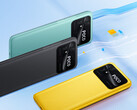Xiaomi Poco F4 GT review - Affordable gaming smartphone with flagship features
With two pop-up triggers, a powerful Snapdragon 8 Gen 1 SoC, and a 120-Hz AMOLED panel, the Poco F4 GT is an exciting smartphone for gaming enthusiasts. Furthermore, Xiaomi has installed two tweeters and two woofers and, according to the manufacturer, the world-first "ultra wideband" vibration motor that produces more powerful vibrations with a frequency of 50 Hz to 500 Hz.
Whereas the availability of the predecessor never officially included Europe - even we were only able to review the normal Poco F3 - the Poco F4 GT is now available globally for around 600 USD. For the price, buyers receive a model with 8 GB of RAM and 128 GB internal storage. The SKU with 12 GB of RAM and 256 GB UFS 3.1 storage costs around 700 USD.
While the battery of the Poco F4 GT is not exceptionally large at 4700 mAh, it can be fully recharged in just 17 minutes with the included 120-watt charger. The main camera of the triple camera contains an IMX686 sensor with a resolution of 64 MP.
Potential Competitors in Comparison
Rating | Date | Model | Weight | Drive | Size | Resolution | Price |
|---|---|---|---|---|---|---|---|
| 85.9 % v7 (old) | 06 / 2022 | Xiaomi Poco F4 GT SD 8 Gen 1, Adreno 730 | 210 g | 256 GB UFS 3.1 Flash | 6.67" | 2400x1080 | |
| 85 % v7 (old) | 03 / 2022 | Nubia RedMagic 7 SD 8 Gen 1, Adreno 730 | 226 g | 256 GB UFS 3.1 Flash | 6.80" | 2400x1080 | |
| 88.7 % v7 (old) | 12 / 2021 | Asus ROG Phone 5s SD 888+ 5G, Adreno 660 | 238 g | 512 GB UFS 3.1 Flash | 6.78" | 2448x1080 | |
| 87.7 % v7 (old) | 03 / 2022 | Xiaomi 12 SD 8 Gen 1, Adreno 730 | 179 g | 256 GB UFS 3.1 Flash | 6.28" | 2400x1080 | |
| 87.9 % v7 (old) | 03 / 2022 | Motorola Edge 30 Pro SD 8 Gen 1, Adreno 730 | 196 g | 256 GB UFS 3.1 Flash | 6.70" | 2400x1080 | |
| 85.7 % v7 (old) | 06 / 2022 | Xiaomi Black Shark 5 Pro SD 8 Gen 1, Adreno 730 | 220 g | 256 GB UFS 3.1 Flash | 6.67" | 2400x1080 |
Case - Xiaomi Smartphone with an RGB LED
In terms of the appearance, the same essentially holds true for the Poco F4 GT as for other gaming smartphones - most people will liikely either love or hate the distinctive design language. The exterior of the gaming phone is defined by its striking back and an RGB gaming LED. This is particularly the case for the yellow color variant. Thanks to the combination of a surface made of protective glass and a metal frame, the Poco F4 feels premium in the hand. Additionally, there are gaming-typical, retractable pop-up triggers. A mechanical slider allows users to quickly switch to the gaming mode.
Although the Gorilla Glass Victus on the front slightly warps around the edges, the screen does not curve. While the 6.67-inch OLED display has fairly slim bezels on the sides, the "chin" bezel of the gaming smartphone is not quite as subtle, resulting in a screen-to-body ratio of a solid 86 %.
The Poco F4 GT does not come with an IP certification for an officially confirmed protection against dust or water. We do not know which seals are in place despite this to prevent water from entering the gaming phone. At least the SIM card slot contains a red-accented, rubberized element.
Connectivity - Poco F4 GT with UFS Storage
As for our test device, the UFS storage has a capacity of 256 GB. Due to the operating system taking up space as well as the preinstalled apps, the actual available storage space is significantly lower at 223 GB. The Poco F4 GT does not offer storage expansion via microSD cards or a 3.5mm headphone jack, which is bound to displease at least some gamers. At least, the gaming phone includes an appropriate USB-C adapter. It is USB 2.0 specified and recognizes external peripherals such as thumb drives via USB-OTG without any issues in our testing.
The Xiaomi phone also comes with an IR blaster, NFC, Bluetooth 5.2, and dual SIM. Additionally, the RGB gaming LED on the back notifies users of incoming calls or messages. Miracast can be used to wirelessly stream screen content to external monitors. Thanks to the completion of the Widevine L1 certifcation process, video content from popular streaming services can be viewed in HD quality.
Software - Xiaomi Phone with Android 12
Xiaomi combines the Android operating system with its own user interface MiUI for Poco version 13. At the time of testing, the Poco phone is based on Android 12 with security patches dating back to May 2022. While the Poco F4 GT is very likely to receive an update to Android 13, we were unable to find an official statement from the manufacturer. The update guarantee for the Xiaomi 12 series, which includes three major Android version updates and security patches for four years does not apply to the Poco smartphone. As such, the software support is likely limited to 3 years at most with 2 major upgrades.
With MiUI 13 for Poco, the F4 GT features an updated MiSans font, various new widgets, and support for Google's "Material You" design. Banner ads and pop-up ads integrated into the MiUI 13 user interface of the Poco model and show up when installing an app, for example. Overall, these so-called MSA (MiUI system ads) can be disabled fairly easily from the system settings under "passwords & security". Similarly, the installed bloatware such as games or Netflix can be uninstalled.
Communication and GNSS - Poco F4 GT with Wi-Fi 6E
The Poco F4 GT is one of the few smartphones around 600 USD, which support the Wi-Fi 6E standard, allowing it to use the 6 gigahertz frequency band for Wi-Fi data transfers. Aside from the up-to-date Wi-Fi standard, the gaming phone also supports multi-user MIMO, which ensures consistent and high transfer rates within home networks. In combination with our Asus ROG Rapture GT-AXE11000 router, the Poco F4 GT reaches peak transfer speeds of more than 1800 Mb/s. Even with a regular Wi-Fi 6 router and in the 2.4-GHz and 5-GHz bands, fast Wi-Fi transmission speeds of above 900 Mb/s can be reached.
For mobile networking, the Poco F4 GT supports all current mobile networking standards including 5G.
| Networking | |
| Xiaomi Poco F4 GT | |
| iperf3 receive AXE11000 | |
| iperf3 transmit AXE11000 | |
| iperf3 transmit AXE11000 6GHz | |
| iperf3 receive AXE11000 6GHz | |
| Nubia RedMagic 7 | |
| iperf3 receive AXE11000 | |
| iperf3 transmit AXE11000 | |
| Asus ROG Phone 5s | |
| iperf3 transmit AX12 | |
| iperf3 receive AX12 | |
| Xiaomi 12 | |
| iperf3 receive AXE11000 | |
| iperf3 transmit AXE11000 | |
| iperf3 transmit AXE11000 6GHz | |
| iperf3 receive AXE11000 6GHz | |
| Motorola Edge 30 Pro | |
| iperf3 receive AXE11000 | |
| iperf3 transmit AXE11000 | |
| Average of class Smartphone | |
| iperf3 receive AXE11000 | |
| iperf3 transmit AXE11000 | |
| iperf3 transmit AXE11000 6GHz | |
| iperf3 receive AXE11000 6GHz | |
In order to assess the locating capabilities in practice, we simultaneously record our route with the Garmin Venu 2 for comparison purposes. For most satellite navigation systems, the Poco F4 GT determines our position via at least dual-band connectivity. Outdoors, the satellite uplink is established quickly with a precision of within about 3 meters. Even indoors, the Xiaomi phone is able to locate us quickly and precisely.
The deviations from the route are very small overall, resulting in identical lines from the gaming phone and the Garmin smartwatch. Even when looking at the detailed GPS recording, there are only minor imprecisions when changing the direction.
Telephony and Call Quality - Xiaomi Smartphone with Dual SIM
While the gaming smartphone accepts up to two nano SIM cards, it does not support an eSIM. The integrated microphones of the Poco F4 GT ensure a good speech quality during calls and video conferences. When put up against the ear, voices are natural sounding and minor ambient noise is filtered out reliably. The speakers offer a good maximum volume level.
Cameras - Poco F4 GT with a Tripe Cam
Although the priorities of a gaming smartphone certainly do not lie with the cameras, the Chinese manufacturer uses the excellent Sony IMX686 camera sensor for the 64-MP main camera. The Asus ROG Phone 5s also uses the same sensor.
Although users should tamper their expectations due to the Poco F4 GT's lack of an optical image stabilization, pictures can turn out quite well. In terms of the sharpness relative to the price of the gaming phone, it often achieves great results. However, under poor lighting conditions some areas tend to be overexposed and close-up objects are out of focus.
Aside from the main camera, the triple cam on the back also contains an 8-MP ultrawide lens and a 2-MP telephoto lens for macro photography and depth-of-field. The pictures taken with the ultrawide camera are solid in terms of the quality overall and even capture surprisingly many details, while the image's sharpness and resolution are somewhat lacking. Unlike the sister model Xiaomi 12, the Poco F4 GT's wide-angle pictures do not suffer from excessive sharpening.
On the front, there is a 20-MP camera hidden inside the puch hole. Selfies offer a good amount of sharpness, although the lighting is not always accurate. Bokeh effects in portrait mode warrant no criticism. There are, however, drawbacks in terms of the video quality (no UHD option).
Similarly, the ultrawide camera is only able to record at up to 1080p 30 FPS. Higher refresh rates or a UHD option are only supported by the 64-MP main camera, which produces convincing recordings at 4K30 thanks to the stabilization working well. The optics cannot be switched between while recording.
Image comparison
Choose a scene and navigate within the first image. One click changes the position on touchscreens. One click on the zoomed-in image opens the original in a new window. The first image shows the scaled photograph of the test device.
WeitwinkelWeitwinkelLow LightUltraweitwinkelZoom 5xWhen it comes to green and brown tones, the color accuracy and balance of pictures taken with the Poco F4 GT does not match that of flagship smartphones. We analyze the color representation of the 64-MP camera under controlled lighting conditions in relation to the reference colors. In our ColorChecker passport test, there are a few outliers (DeltaE values >15).
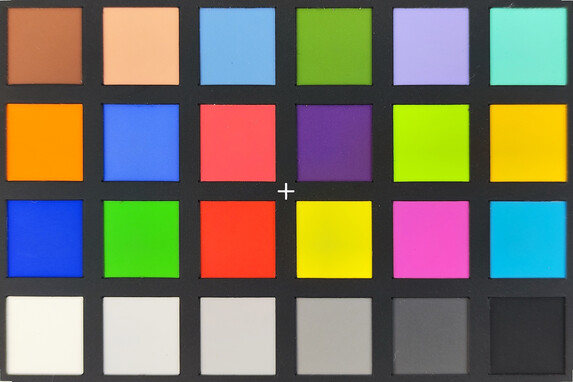

Accessories and Warranty - Xiaomi Smartphone with a 120W Charger
The scope of delivery for the Poco F4 GT includes a 120W charger, a protective cover, a 1.5m (~4.9 ft), L-shaped USB-C cable, a quick-start guide, and a SIM toolkit. The gaming smartphone also includes a type-C-to-3.5mm adapter.
For the international model, the Poco phone includes a 6-month warranty for the battery and accessories as well as a 12-month limited warranty for the device itself. If you purchase the Poco F4 GT between April 26th 2022 and April 26th 2023, you may be eligible for a free screen repair, if the display has been accidentally damaged.
Input Devices & Handling - Poco F4 GT with 480 Hz
For its gaming smartphone, Xiaomi uses a super-wideband X-axis vibration motor. With 560 mm³, this is the potentially biggest one in an Android device, according to the manufacturer. During daily use, the Poco F4 GT produces a comfortable haptic feedback, making typing on the OLED panel a very pleasant experience.
Not just the vibration motor benefits the user experience, however, but also the the high refresh rate of 120 Hz and the high sampling rate of up to 480 Hz. The latter checks the capacitive multi touchscreen for inputs up to 480 times per second while gaming. As a result, the capacitive touchscreen is able to respond quickly to inputs.
Instead of residing below the OLED display, the fingerprint sensor of the Poco F4 GT has been integrated into the power button. This appears to have been a good decision, since it recognizes our fingers quickly and precisely. Alternatively, the front camera can be used for facial recognition. However, the biometric authentication via facial recognition is not very secure due to the use of 2D data.
Display - Xiaomi Smartphone with an OLED Panel
The Poco F4 GT features a 6.67-inch AMOLED display with a resolution of 2400 x 1080 pixels and a refresh rate of 120 Hz. Although the gaming phone from Xiaomi does not rely on an LTPO panel, which supports variable frequencies, the F4 GT is able to switch between 60 Hz and 120 Hz automatically.
The display is rated for a maximum of 800 nits panel brightness by the Chinese manufacturer, which almost exactly matches our measurements when displaying a purely white image with the ambient light sensor enabled. With an even distribution of bright and dark areas, the Poco smartphone reaches an excellent result of 914 nits in the APL18 test. This makes the OLED panel suitable for HDR content.
Due to the OLED panel, the Poco F4 GT suffers from screen flickering. According to our measurements, the PWM frequency barely fluctuates and stays at a relatively consistent 120 Hz. Xiaomi advertises the Poco F4 GT with a very high PWM frequency of 1920 Hz, which would be much more pleasant, particularly for sensitive users. We were unable to determine whether the cause of the differences lies in our measuring equipment or if the automatic DC dimming mode was not enabled.
| |||||||||||||||||||||||||
Brightness Distribution: 99 %
Center on Battery: 807 cd/m²
Contrast: ∞:1 (Black: 0 cd/m²)
ΔE ColorChecker Calman: 1.2 | ∀{0.5-29.43 Ø4.78}
ΔE Greyscale Calman: 2.2 | ∀{0.09-98 Ø5}
98.7% sRGB (Calman 2D)
Gamma: 2.2
CCT: 6439 K
| Xiaomi Poco F4 GT AMOLED, 2400x1080, 6.7" | Nubia RedMagic 7 AMOLED, 2400x1080, 6.8" | Asus ROG Phone 5s AMOLED, 2448x1080, 6.8" | Xiaomi 12 OLED, 2400x1080, 6.3" | Motorola Edge 30 Pro AMOLED, 2400x1080, 6.7" | |
|---|---|---|---|---|---|
| Screen | -80% | -1% | -9% | 5% | |
| Brightness middle (cd/m²) | 807 | 683 -15% | 749 -7% | 867 7% | 649 -20% |
| Brightness (cd/m²) | 806 | 685 -15% | 750 -7% | 867 8% | 649 -19% |
| Brightness Distribution (%) | 99 | 95 -4% | 97 -2% | 98 -1% | 98 -1% |
| Black Level * (cd/m²) | |||||
| Colorchecker dE 2000 * | 1.2 | 3.6 -200% | 1.4 -17% | 1.7 -42% | 1.18 2% |
| Colorchecker dE 2000 max. * | 3.1 | 6.7 -116% | 2.8 10% | 4.4 -42% | 2.07 33% |
| Greyscale dE 2000 * | 2.2 | 5 -127% | 1.8 18% | 1.8 18% | 1.5 32% |
| Gamma | 2.2 100% | 2.14 103% | 2.29 96% | 2.2 100% | 2.236 98% |
| CCT | 6439 101% | 7537 86% | 6602 98% | 6762 96% | 2538 256% |
* ... smaller is better
Screen Flickering / PWM (Pulse-Width Modulation)
| Screen flickering / PWM detected | 121.4 Hz | ||
The display backlight flickers at 121.4 Hz (worst case, e.g., utilizing PWM) . The frequency of 121.4 Hz is very low, so the flickering may cause eyestrain and headaches after extended use. In comparison: 53 % of all tested devices do not use PWM to dim the display. If PWM was detected, an average of 8098 (minimum: 5 - maximum: 343500) Hz was measured. | |||
Measurements at a fixed zoom level and various brightness settings
In typical OLED-fashion, the Poco F4 GT's display has an absolute black value for an (in theory) perfect contrast ratio. There are three color presets and a lot of customizable settings. In addition to the various profiles, single display characteristics, such as the saturation or gamma, can be controlled manually.
When using the factory settings (profile: original), the smartphone is able to fully cover the fairly small sRGB color space. The color accuracy is highly accurate with low DeltaE values of less than 3. Similarly, the grayscale does not suffer from any color deviations.
Display Response Times
| ↔ Response Time Black to White | ||
|---|---|---|
| 1.14 ms ... rise ↗ and fall ↘ combined | ↗ 0.557 ms rise | |
| ↘ 0.585 ms fall | ||
| The screen shows very fast response rates in our tests and should be very well suited for fast-paced gaming. In comparison, all tested devices range from 0.1 (minimum) to 240 (maximum) ms. » 5 % of all devices are better. This means that the measured response time is better than the average of all tested devices (20.2 ms). | ||
| ↔ Response Time 50% Grey to 80% Grey | ||
| 0.89 ms ... rise ↗ and fall ↘ combined | ↗ 0.423 ms rise | |
| ↘ 0.468 ms fall | ||
| The screen shows very fast response rates in our tests and should be very well suited for fast-paced gaming. In comparison, all tested devices range from 0.165 (minimum) to 636 (maximum) ms. » 3 % of all devices are better. This means that the measured response time is better than the average of all tested devices (31.6 ms). | ||
Outdoors, the Poco phone's display contents remain easily readable. While the gaming smartphone offers enough brightness reserves even for sunny days, the excessive glare may then become distracting. The cheaper model does not hold a candle to the outstanding luminosity of a Xiaomi 12 Pro.
The AMOLED display has excellent viewing angles. Even when viewed from an extreme angle, there are no major color distortions.
Performance - Poco F4 GT with a Qualcomm SoC
For the Poco F4 GT, Xiaomi has opted to use Qualcomm's best smartphone chipset to date. The Snapdragon 8 Gen. 1 is a 4nm SoC with an integrated Adreno 730 for graphics acceleration. The system performance during day-to-day use leaves nothing to be desired. Animations are smooth and there is no noticeable stuttering. The CPU benchmark results are on par with those of other smartphones with this SoC overall, although the AImark score is somewhat low.
| AImark - Score v2.x | |
| Average Qualcomm Snapdragon 8 Gen 1 (1046 - 96317, n=14) | |
| Xiaomi Poco F4 GT | |
| Xiaomi 12 | |
While the GPU performance is very fast as well, the Poco F4 GT surprisingly does not reach the same scores as the Xiaomi 12, which uses the same Snapdragon 8 Gen 1. Although the high ambient temperatures at the time of testing may be partially responsible, a gaming phone should still produce more consistent frame rates - there is noticeable throttling during the Manhattan onscreen benchmark, for example.
GFXBench (DX / GLBenchmark) 2.7: T-Rex Onscreen | 1920x1080 T-Rex Offscreen
GFXBench 3.0: on screen Manhattan Onscreen OGL | 1920x1080 1080p Manhattan Offscreen
GFXBench 3.1: on screen Manhattan ES 3.1 Onscreen | 1920x1080 Manhattan ES 3.1 Offscreen
GFXBench: on screen Car Chase Onscreen | 1920x1080 Car Chase Offscreen | on screen Aztec Ruins High Tier Onscreen | 2560x1440 Aztec Ruins High Tier Offscreen | on screen Aztec Ruins Normal Tier Onscreen | 1920x1080 Aztec Ruins Normal Tier Offscreen
| 3DMark / Wild Life Extreme Unlimited | |
| Nubia RedMagic 7 | |
| Xiaomi Poco F4 GT | |
| Xiaomi 12 | |
| Motorola Edge 30 Pro | |
| Asus ROG Phone 5s | |
| 3DMark / Wild Life Extreme | |
| Nubia RedMagic 7 | |
| Xiaomi 12 | |
| Xiaomi Poco F4 GT | |
| Motorola Edge 30 Pro | |
| Asus ROG Phone 5s | |
| 3DMark / Wild Life Unlimited Score | |
| Nubia RedMagic 7 | |
| Xiaomi Poco F4 GT | |
| Xiaomi 12 | |
| Motorola Edge 30 Pro | |
| Asus ROG Phone 5s | |
| 3DMark / Sling Shot Extreme (ES 3.1) Unlimited Physics | |
| Asus ROG Phone 5s | |
| Nubia RedMagic 7 | |
| Xiaomi 12 | |
| Xiaomi Poco F4 GT | |
| 3DMark / Sling Shot Extreme (ES 3.1) Unlimited Graphics | |
| Nubia RedMagic 7 | |
| Xiaomi 12 | |
| Xiaomi Poco F4 GT | |
| Asus ROG Phone 5s | |
| 3DMark / Sling Shot Extreme (ES 3.1) Unlimited | |
| Nubia RedMagic 7 | |
| Xiaomi 12 | |
| Xiaomi Poco F4 GT | |
| Asus ROG Phone 5s | |
| 3DMark / Sling Shot OpenGL ES 3.0 Unlimited | |
| Nubia RedMagic 7 | |
| Xiaomi Poco F4 GT | |
| Asus ROG Phone 5s | |
| Xiaomi 12 | |
| 3DMark / Sling Shot OpenGL ES 3.0 Unlimited Graphics | |
| Nubia RedMagic 7 | |
| Xiaomi 12 | |
| Xiaomi Poco F4 GT | |
| Asus ROG Phone 5s | |
| 3DMark / Sling Shot OpenGL ES 3.0 Unlimited Physics | |
| Asus ROG Phone 5s | |
| Nubia RedMagic 7 | |
| Xiaomi Poco F4 GT | |
| Xiaomi 12 | |
| GFXBench (DX / GLBenchmark) 2.7 / T-Rex Onscreen | |
| Xiaomi 12 | |
| Xiaomi Poco F4 GT | |
| Motorola Edge 30 Pro | |
| GFXBench (DX / GLBenchmark) 2.7 / T-Rex Offscreen | |
| Xiaomi 12 | |
| Xiaomi Poco F4 GT | |
| Motorola Edge 30 Pro | |
| GFXBench 3.0 / Manhattan Onscreen OGL | |
| Xiaomi 12 | |
| Motorola Edge 30 Pro | |
| Xiaomi Poco F4 GT | |
| GFXBench 3.0 / 1080p Manhattan Offscreen | |
| Xiaomi 12 | |
| Xiaomi Poco F4 GT | |
| Motorola Edge 30 Pro | |
| GFXBench 3.1 / Manhattan ES 3.1 Onscreen | |
| Xiaomi 12 | |
| Xiaomi Poco F4 GT | |
| Motorola Edge 30 Pro | |
| GFXBench 3.1 / Manhattan ES 3.1 Offscreen | |
| Xiaomi 12 | |
| Xiaomi Poco F4 GT | |
| Motorola Edge 30 Pro | |
| GFXBench / Car Chase Onscreen | |
| Xiaomi 12 | |
| Xiaomi Poco F4 GT | |
| Motorola Edge 30 Pro | |
| GFXBench / Car Chase Offscreen | |
| Motorola Edge 30 Pro | |
| Xiaomi Poco F4 GT | |
| Xiaomi 12 | |
| GFXBench / Aztec Ruins High Tier Onscreen | |
| Xiaomi 12 | |
| Motorola Edge 30 Pro | |
| Nubia RedMagic 7 | |
| Xiaomi Poco F4 GT | |
| Asus ROG Phone 5s | |
| GFXBench / Aztec Ruins High Tier Offscreen | |
| Nubia RedMagic 7 | |
| Motorola Edge 30 Pro | |
| Xiaomi 12 | |
| Xiaomi Poco F4 GT | |
| Asus ROG Phone 5s | |
| GFXBench / Aztec Ruins Normal Tier Onscreen | |
| Motorola Edge 30 Pro | |
| Xiaomi 12 | |
| Nubia RedMagic 7 | |
| Asus ROG Phone 5s | |
| Xiaomi Poco F4 GT | |
| GFXBench / Aztec Ruins Normal Tier Offscreen | |
| Nubia RedMagic 7 | |
| Xiaomi Poco F4 GT | |
| Motorola Edge 30 Pro | |
| Xiaomi 12 | |
| Asus ROG Phone 5s | |
The browser benchmark results are on the weaker side as well - the Speedometer benchmark results of the Poco phone are particularly poor. We used the Edge browser, since the scores were even lower when using Chrome. During day-to-day use, browsing the web with the Poco F4 GT works inconspicuously well.
| Jetstream 2 - 2.0 Total Score | |
| Average of class Smartphone (23.8 - 387, n=149, last 2 years) | |
| Motorola Edge 30 Pro (Chrome 99) | |
| Xiaomi 12 (Chrome 99.0.4844.58) | |
| Average Qualcomm Snapdragon 8 Gen 1 (72.8 - 134.6, n=16) | |
| Xiaomi Poco F4 GT (MS Edge 102) | |
| Speedometer 2.0 - Result 2.0 | |
| Average of class Smartphone (15.2 - 643, n=122, last 2 years) | |
| Motorola Edge 30 Pro (Chome 99) | |
| Xiaomi 12 (Chrome 99.0.4844.58) | |
| Average Qualcomm Snapdragon 8 Gen 1 (64.4 - 129.3, n=16) | |
| Xiaomi Poco F4 GT (MS Edge 102) | |
| WebXPRT 3 - Overall | |
| Average of class Smartphone (38 - 380, n=31, last 2 years) | |
| Motorola Edge 30 Pro (Chrome 99) | |
| Xiaomi 12 (Chrome 99.0.4844.58) | |
| Average Qualcomm Snapdragon 8 Gen 1 (79 - 193, n=15) | |
| Xiaomi Poco F4 GT (MS Edge 102) | |
| Octane V2 - Total Score | |
| Motorola Edge 30 Pro (Chrome 99) | |
| Average of class Smartphone (2228 - 121337, n=197, last 2 years) | |
| Average Qualcomm Snapdragon 8 Gen 1 (27730 - 50626, n=17) | |
| Xiaomi 12 (Chrome 99.0.4844.58) | |
| Xiaomi Poco F4 GT (MS Edge 102) | |
| Mozilla Kraken 1.1 - Total | |
| Xiaomi Poco F4 GT (MS Edge 102) | |
| Average of class Smartphone (257 - 28190, n=155, last 2 years) | |
| Average Qualcomm Snapdragon 8 Gen 1 (814 - 1440, n=16) | |
| Xiaomi 12 (Chrome 99.0.4844.58) | |
| Motorola Edge 30 Pro (Chrome 99) | |
* ... smaller is better
The Poco F4 GT uses very fast UFS 3.1 storage and reaches good results in AndroBench. The write speeds are particularly fast compared to the Asus ROG Phone 5s, which can be at least partially attributed to the newer memory controller of the Snapdragon 8 Gen 1.
| Xiaomi Poco F4 GT | Nubia RedMagic 7 | Asus ROG Phone 5s | Xiaomi 12 | Motorola Edge 30 Pro | Average 256 GB UFS 3.1 Flash | Average of class Smartphone | |
|---|---|---|---|---|---|---|---|
| AndroBench 3-5 | -16% | -22% | -2% | -18% | -17% | 3% | |
| Sequential Read 256KB (MB/s) | 1832.34 | 1750 -4% | 1972 8% | 1851 1% | 1832 0% | 1757 ? -4% | 2228 ? 22% |
| Sequential Write 256KB (MB/s) | 1482.42 | 1260 -15% | 770 -48% | 1417 -4% | 1028 -31% | 1204 ? -19% | 1852 ? 25% |
| Random Read 4KB (MB/s) | 328.58 | 306.2 -7% | 297.8 -9% | 325.2 -1% | 277.7 -15% | 287 ? -13% | 296 ? -10% |
| Random Write 4KB (MB/s) | 457.69 | 282.5 -38% | 287.2 -37% | 437.5 -4% | 339.5 -26% | 318 ? -31% | 339 ? -26% |
Gaming - Poco F4 GT with 120 FPS
Fast response times, a high refresh rate of 120 Hz, and a sampling rate of up to 480 Hz combined with the Adreno 730 promises a great gaming experience. The gaming microphone on the side ensures that voices are captured clearly in landscape mode.
The graphics performance is high enough for a consistent 40 FPS in PUBG mobile at the UHD setting. We did not encounter any frame rate dips even at reduced quality settings. At a lower detail setting (HD preset), we recorded a maximum of 60 FPS. Various commands can be assigned to the magnetic pop-up triggers made of elastic silicone, similar to the triggers on a game controller. This is very useful for the shooter from Tencent Games. Even during day-to-day use, several shortcuts can be assigned to the extra buttons such as the flashlight feature for more comfort during normal use.
Furthermore, we used the GameBench app to take a look at a less demanding game from the Play Store. For a short period of time, Armajet can be played at high graphics settings near the native refresh rate of the 120-Hz panel. However, we experienced significant frame rate dips while playing the arena shooter, resulting in an average frame rate of just 90 FPS.
Emissions - Xiaomi Smartphone with Good Cooling
Temperature
Xiaomi boasts the Poco F4 GT's LiquidCool technology 3.0, which includes two stainless steel vapor chambers combined with a 3D graphite layer to ensure an efficient heat transfer from the iniside to the outside. Unlike the Nubia RedMagic 7, the Poco phone does not come with an active fan.
Unfortunately, not much of the improved LiquidCool technology is apparent during daily use, since the heat development causes the Qualcomm SoC to reduce its performance significantly. However, the surface temperatures of the case are not too hot even under load.
Even though the F4 GT completes the stress test of the GFX benchmark, which consists of runninig the OpenGL ES 3.1 scenario thirty times in succession, it is not possible to read out the results. Subsequently, the Poco F4 GT has to prove itself in the 3DMark stress tests. The Snapdragon 8 Gen1 quickly throttles in both test scenarios by about 50 %, representing a massiive decrease in performance. Thus, a decrease in the frame rate during prolonged day-to-day use of demanding apps cannot be ruled out.
(+) The maximum temperature on the upper side is 37.1 °C / 99 F, compared to the average of 35.2 °C / 95 F, ranging from 21.9 to 247 °C for the class Smartphone.
(+) The bottom heats up to a maximum of 36.8 °C / 98 F, compared to the average of 34 °C / 93 F
(+) In idle usage, the average temperature for the upper side is 27.9 °C / 82 F, compared to the device average of 32.9 °C / 91 F.
3DMark Wild Life Stress Test
| 3DMark | |
| Wild Life Stress Test Stability | |
| Asus ROG Phone 5s | |
| Nubia RedMagic 7 | |
| Nubia RedMagic 7 | |
| Motorola Edge 30 Pro | |
| Xiaomi Poco F4 GT | |
| Xiaomi 12 | |
| Wild Life Extreme Stress Test | |
| Nubia RedMagic 7 | |
| Asus ROG Phone 5s | |
| Motorola Edge 30 Pro | |
| Xiaomi Poco F4 GT | |
| Xiaomi 12 | |
Speakers
The Poco F4 GT's stereo speaker setup with two independent tweeters and two woofers makes for a stellar stereo sound. We are also pleased with the sound overall, although the lower frequencies are somewhat thin and the treble falls off slightly compared to the relatively linear mids.
Wired headphones or external speakers can be connected via the USB type-C port. The audio codecs SBC, AAC, aptX, aptXHD, and aptX adaptive as well as LDAC and LHDC are available for users who prefer using Bluetooth for wireless audio output.
Xiaomi Poco F4 GT audio analysis
(+) | speakers can play relatively loud (86.6 dB)
Bass 100 - 315 Hz
(-) | nearly no bass - on average 16.5% lower than median
(±) | linearity of bass is average (9.9% delta to prev. frequency)
Mids 400 - 2000 Hz
(±) | higher mids - on average 7.1% higher than median
(+) | mids are linear (4.5% delta to prev. frequency)
Highs 2 - 16 kHz
(±) | higher highs - on average 5.1% higher than median
(+) | highs are linear (4.8% delta to prev. frequency)
Overall 100 - 16.000 Hz
(±) | linearity of overall sound is average (17.5% difference to median)
Compared to same class
» 12% of all tested devices in this class were better, 8% similar, 79% worse
» The best had a delta of 11%, average was 35%, worst was 134%
Compared to all devices tested
» 33% of all tested devices were better, 8% similar, 59% worse
» The best had a delta of 4%, average was 24%, worst was 134%
Nubia RedMagic 7 audio analysis
(+) | speakers can play relatively loud (91.8 dB)
Bass 100 - 315 Hz
(-) | nearly no bass - on average 21.9% lower than median
(+) | bass is linear (6.9% delta to prev. frequency)
Mids 400 - 2000 Hz
(±) | higher mids - on average 5.8% higher than median
(+) | mids are linear (4.5% delta to prev. frequency)
Highs 2 - 16 kHz
(±) | higher highs - on average 6.9% higher than median
(+) | highs are linear (4.8% delta to prev. frequency)
Overall 100 - 16.000 Hz
(±) | linearity of overall sound is average (18.9% difference to median)
Compared to same class
» 23% of all tested devices in this class were better, 10% similar, 68% worse
» The best had a delta of 11%, average was 35%, worst was 134%
Compared to all devices tested
» 43% of all tested devices were better, 8% similar, 49% worse
» The best had a delta of 4%, average was 24%, worst was 134%
Battery Life - Poco F4 GT with Fast Charging
Energy Consumption
The dual-cell battery of the Poco smartphone has a capacity of 4700 mAh and supports Xiaomi's own fast-charging technology at up to 120 watts. We were pleased to find an appropriate charger with a total charging time of less than 20 minutes already included with the gaming phone. While gaming, fully recharging the battery takes about 30 minutes. In order to prolong the battery life, the Poco F4 GT detects when it is being charged at night. The charging process is then interrupted at 80 % and continues just before the calculated wake-up time. The Poco F4 GT does not support wireless charging.
The overall energy consumption is similar to that of the Xiaomi 12. Interestingly, Xiaomi phones have a much lower peak consumption compared to the Motorola Edge 30 Pro.
| Off / Standby | |
| Idle | |
| Load |
|
Key:
min: | |
| Xiaomi Poco F4 GT 4700 mAh | Xiaomi 12 4500 mAh | Motorola Edge 30 Pro 4800 mAh | Average Qualcomm Snapdragon 8 Gen 1 | Average of class Smartphone | |
|---|---|---|---|---|---|
| Power Consumption | -2% | -26% | -26% | -16% | |
| Idle Minimum * (Watt) | 1 | 0.87 13% | 1.2 -20% | 1.255 ? -26% | 0.842 ? 16% |
| Idle Average * (Watt) | 1.53 | 1.7 -11% | 1.6 -5% | 2.02 ? -32% | 1.439 ? 6% |
| Idle Maximum * (Watt) | 1.57 | 1.82 -16% | 2.5 -59% | 2.21 ? -41% | 1.624 ? -3% |
| Load Average * (Watt) | 4.39 | 4.68 -7% | 5.2 -18% | 5.49 ? -25% | 7.03 ? -60% |
| Load Maximum * (Watt) | 8.1 | 7.41 9% | 10.4 -28% | 8.75 ? -8% | 11.3 ? -40% |
* ... smaller is better
Energy Consumption: Geekbench (150 nits)
Energy Consumption: GFXBench (150 nits)
Battery Life
While our test model reaches solid results when it comes to the battery life, other devices from our comparison tend to last slightly longer than the Poco F4 GT. For a meaningful comparison, we compared the runtimes at a reduced brightness level of 150 nits. With a refresh rate of 120 Hz, the Xiaomi phone lasts almost 12.5 hours in our Wi-Fi test and over 16.5 hours in our video test. By contrast, the runtimes under load at maximum brightness are relatively poor.
| Xiaomi Poco F4 GT 4700 mAh | Nubia RedMagic 7 4500 mAh | Asus ROG Phone 5s 6000 mAh | Xiaomi 12 4500 mAh | Motorola Edge 30 Pro 4800 mAh | |
|---|---|---|---|---|---|
| Battery runtime | -11% | -2% | 39% | 24% | |
| Reader / Idle (h) | 26 | 42.6 64% | 33.1 27% | ||
| H.264 (h) | 16.5 | 14.8 -10% | 16.8 2% | ||
| WiFi v1.3 (h) | 12.5 | 11.1 -11% | 12.2 -2% | 12.7 2% | 13.6 9% |
| Load (h) | 3.2 | 6.4 100% | 5.1 59% |
Pros
Cons
Verdict on the Xiaomi Poco F4 GT
Although the Poco F4 GT is a great smartphone, it falls behind competitors in the gaming department. Unlike the Nubia RedMagic 7 and the Asus ROG Phone 5s, which feature an integrated and an attachable fan, respectively, the Poco F4 GT has to make do with a traditional vapor chamber. Aside from high surface temperatures, this also results in inconsistent performance and throttling of the Snapdragon 8 Gen 1 as well as low runtimes when under load. As our gaming tests show, this can become an issue in HFR titles - here, the Asus ROG Phone 5 performs much more consistently at frame rates in excess of 100 FPs.
The Poco F4 GT is a lot of smartphone for a cheap price. We were very pleased to see a 120W charger included with the Xiaomi phone.
However, our verdict on the Poco F4 GT as a "normal" mid-range phone is significantly better. Despite the throttling, it offers a lot of performance for around 600 USD, fast storage, and an excellent speaker system. Thanks to the fast response times of the OLED panel and a fast refresh rate of 120 Hz, the Xiaomi smartphone and its triggers still make for an enjoyable gaming experience, albeit with the above constraints.
Price and Availability
The Poco F4 GT is available for an MSRP of 605 USD, for example on Amazon.com.
Xiaomi Poco F4 GT
- 08/30/2022 v7 (old)
Marcus Herbrich





